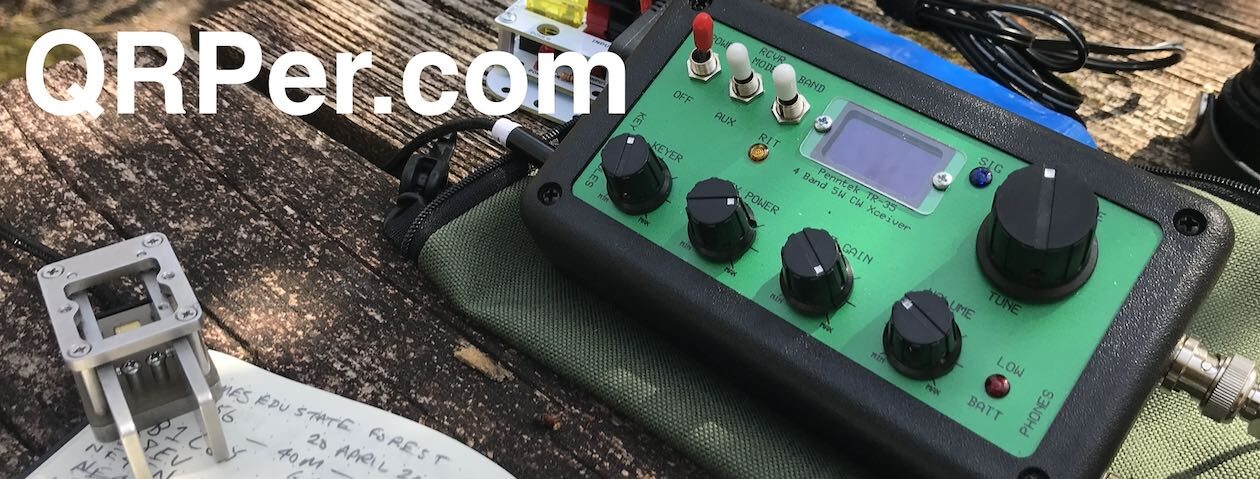Many thanks to Jeff (K9JP) who shares the following guest post:
Simple-for-me POTA activations
Jeff (K9JP)
This past year, I discovered POTA and the joy of activating parks. This part of amateur radio is very rewarding to me. I started activating parks in March, which means cold and possibly snowy days. I took the easy way and set up my POTA station inside of my car with the engine running to power the radio and the car heater creating warmth, but increasing my carbon footprint.
I soon recognized that had to be a better way.
I was using a magnetic-mounted ham-stick type of antenna on the roof of my car to make the antenna easy to use. I had problems getting my ham-stick antennas to resonate, did a little web research, and found that I needed to bond the coax feedline to the body of the car. I made up a pass-through coax connection using a chassis mount connector and a short length of one-inch ground braid that I had in my spare parts stash. I attached the braid to one of the back set floor bolts
Now the antenna was resonating and working well. For my radio, I used my backup ICOM IC-7300 with a power output set to 4 watts for QRP Fun. I can use all bands from 20 through 6 meters now.
 My next change was to purchase a rechargeable LiFePo4 battery.. Looking at the cost per amp hours, I decided on a 100 Ah battery that offered a possible 2000 charge cycles. It should last for years with good care. With the large capacity of that battery, I can power the 7300 for many hours at QRP power levels and operate either FT8/FT4 or CW, and would also make high power possible if needed for some reason or other operating event. My experience so far has been I can operate from five parks per day and only need to charge the battery after the fourth day or about 20 activations.
My next change was to purchase a rechargeable LiFePo4 battery.. Looking at the cost per amp hours, I decided on a 100 Ah battery that offered a possible 2000 charge cycles. It should last for years with good care. With the large capacity of that battery, I can power the 7300 for many hours at QRP power levels and operate either FT8/FT4 or CW, and would also make high power possible if needed for some reason or other operating event. My experience so far has been I can operate from five parks per day and only need to charge the battery after the fourth day or about 20 activations.
I have recently purchased a Ford Transit Connect minivan to convert for my POTA Park mobile adventures. The van offered a better way to mount the antennas I use. It has a roof rack with cross-bars.
 I modified an older Diamond roof rack mount to fit the wider cross bars.
I modified an older Diamond roof rack mount to fit the wider cross bars.
 Once I installed the coax bonding strap under the center-row seat I was ready to go.
Once I installed the coax bonding strap under the center-row seat I was ready to go.
I had also received a 40-meter ham-stick type antenna and thought I would give that band a go on my next park activation. Again no joy, I could not get the 40-meter antenna to resonate. When I got back home, I made up a 1/2″ grounding braid strap long enough to bond or connect the roof rack mount to the body of the minivan. I covered this strap with dual wall adhesive lined heat shrink tubing.
 This bonding strap is connected to the roof rack mount, runs under the side door weather stripping, and is terminated under the side door latch.
This bonding strap is connected to the roof rack mount, runs under the side door weather stripping, and is terminated under the side door latch.
Now the 40-meter resonator was working very well.
How could I add 60, 80, or 160-meter bands? Giving that some thought, could I try to create a sort of 1/2 fan dipole? Yes, I could! Through experimentation, I made up clamp-on elements for 60, 80, and 160-meter bands. Those can be attached or clamped on the quick disconnects I have on all my ham stick antennas.
 I support the clamp-on elements by either draping the wire element over nearby shrubs or small trees or by just using a plastic step-on fencing post that I found at my local farm and home supply store. It only costs $3.00. These elements create an NVIS radiation pattern which helps reach out to interstate POTA hunters.
I support the clamp-on elements by either draping the wire element over nearby shrubs or small trees or by just using a plastic step-on fencing post that I found at my local farm and home supply store. It only costs $3.00. These elements create an NVIS radiation pattern which helps reach out to interstate POTA hunters.
 Inside the minivan, I place my portable LiFePo4 battery, 7300 radio, and my laptop for digital modes and logging.
Inside the minivan, I place my portable LiFePo4 battery, 7300 radio, and my laptop for digital modes and logging.
 I hope you will find this helpful. I believe this is a simple way to activate parks.
I hope you will find this helpful. I believe this is a simple way to activate parks.
I now have 186 activations, from 23 parks, and 4800 contacts using 160 through 6-meter bands. Many thanks to all I have contacted this past year and my goal for 2024 is to try and activate more Michigan, Ohio, and South West Canada parks using QRP power levels.
72/73 de Jeff K9JP






































